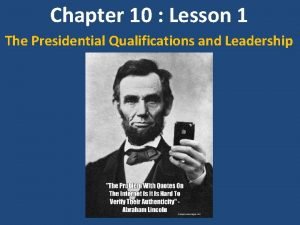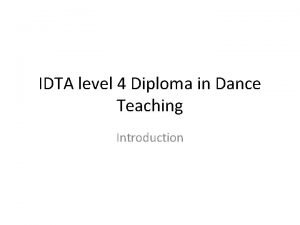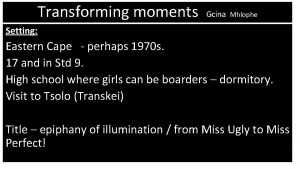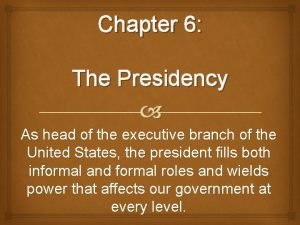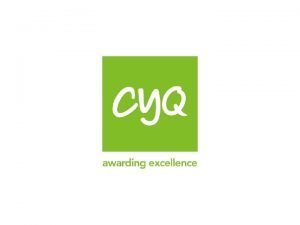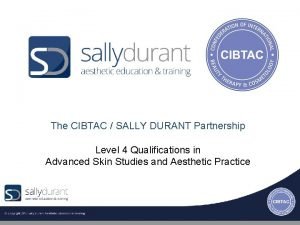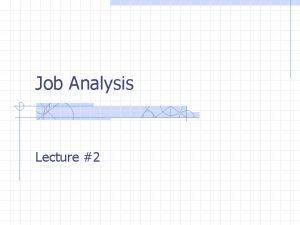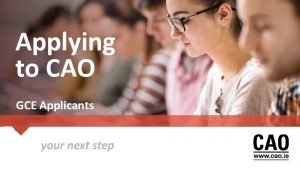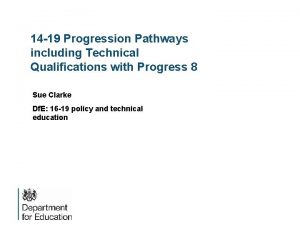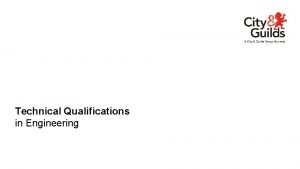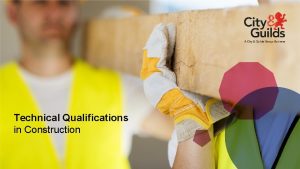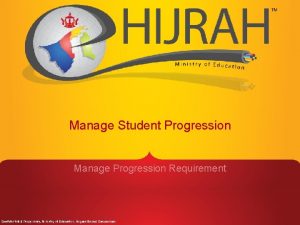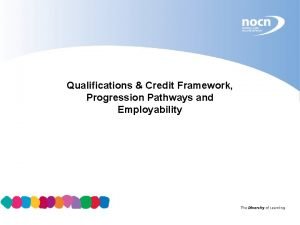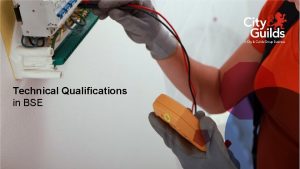14 19 Progression Pathways including Technical Qualifications with












- Slides: 12

14 -19 Progression Pathways including Technical Qualifications with Progress 8 Sue Clarke Df. E: 16 -19 policy and technical education

Meet Sam § Sam wants a career in digital skills § The local FE colleges all offer different qualifications – they all look good in the prospectus, but Sam doesn’t know which qualifications will be accepted by employers when she comes to apply for a job § Employment websites were no help – all employers seemed to want was experience § Sam wants to keep her options open with a view to possibly returning to academic study later on, so her school advises her to spend two years studying A levels before she specialises in digital skills

What does Sam’s story tell us about the current system? § The current skills system is incredibly complex, with over 13, 000 competing qualifications for 16– 18 year-olds. This causes confusion for schools, providers, employers, students and parents § Many of the available qualifications do not prepare students for employment. Many are low quality – only 173 meet the Df. E tech level requirements § Work experience lasting 1 or 2 weeks does not give students the opportunity to develop the specific practical knowledge and skills for the profession they are pursuing § Students feel that they are ‘locked into’ their choice of either academic or technical education at 16. There is no clear pathway if they want to switch. § Too many students see A levels as the ‘safe’ option, then switch to technical education after 1 or 2 years, often at the same or lower level

How will the reforms help Sam? § Sam will be offered two clear pathways – one academic and one technical – Within the technical option, students will be able to choose between college based study or an apprenticeship – Bridging provision will enable students to move between pathways at age 18 – Sam can begin her technical education knowing that it will give her the opportunity to progress to higher education if that is what she wants § Sam is expected to get good GCSEs. But if she needed more time to develop her basic skills, Sam could start with a ‘transition year’ – The transition year will support young people to develop realistic career plans, and offer tailored education to help them to achieve those plans. Literacy and numeracy will be key elements

The two pathways, with bridging provision Skilled employment Higher education (undergraduate degree) Higher education (level 4/5 technical education) Higher education (undergraduate degree) A levels and/or Applied General qualifications A levels and/or applied general qualifications** Transition year (If appropriate) GCSEs and Technical Awards Academic option Bridging provision (where appropriate) College-based technical education including placement in industry Degree apprenticeships and higher apprenticeships Employment-based technical education, eg apprenticeship in industry with some college-based education Transition year and/or traineeship (If appropriate) GCSEs and Technical Awards Technical education option GCSEs and technical awards – progress 8

How will the reforms help Sam? § There will be two clear pathways – one academic and one technical § There will be 15 routes, each covering a cluster of occupations – Occupational standards, set by employers, will underpin all technical education, with one standard per occupation – A single organisation will be granted an exclusive licence to develop and deliver the qualification that meets the standard set by employers – So, Sam won’t be faced with the bewildering range of courses that are available today

r icer d off (Number employed in occupations within route, excluding graduate roles) Protective Services (398, 400) Sales, Marketing and Procurement (957, 185) Social Care (865, 941) r riv e (293, 004) Vd Hair and Beauty ician (1, 625, 448) Health and Science (915, 979) Transport and Logistics (589, 509) ian eg ral chnic Pa unting te Acco Financial account manager Lega l secr etary Pa yro ll m an ag er Construction al n chn De ratory te o b La Pharmaceutical technician Spor ts the rapis Nu t rsi ng as sis tan t e urs (454, 726) HG r n tal rbe Ba Beauty therapist H r se Childcare and Education Railway signalling technician S (1, 319, 645) es (568, 998) r Engineering and Manufacturing dr air ian l chnic hic ing te Ve r e e Engin Energy plant operative Proce ss te chnic Air ian cra ft f itte r (2, 204, 478) ice nic Catering and Hospitality ff ’s o hip Route name ha Business and Administrative er ork w n re arde Ca tial w n e id Res Welfare counsellor Prob ation office Ho r me ca rer (351, 649) r r ye office Bu urement Proc Sales account manager Mark et res earch Es analy tat st ea ge nt Digital ec em er mm a r g loper Pro are deve w Soft Network administrator Web desig ner IT tec hn icia n Agriculture, Environmental and Animal Care Marit ime o perat Fir ions es office erv r ice off ice r ne Po issio comm n o N e ffic Examples of occupations to which the route could lead o lice on s ma r ce du o r sp ner Art hic desig p a r G Audio-visual technician Upho lstere r Jo urn ali st Cons tructio Ca n sup ervis rpe or nte r/jo ine r Building/civil engineering technician ck Bri trician le E c er/ lay Teac hing assis Yo tant uth wo rke r ry rse er Nu s offic year ly r a E t n ista s as er ef Ch ts manag n e Ev Catering manager Butch er Ba ke r Admin istrat ive o Ho fficer us ing off ice r er fic s offic Of urce o s e an r Hum er ag an em r ge an r rk ist Pa ervation Cons Agricultural Technician Hortic ultura list Fa rm er The 15 new technical routes to skilled employment Creative and Design (1, 060, 804) (529, 573) Legal, Finance and Accounting (1, 325, 482) We expect these routes to be delivered primarily through apprenticeships.

How will the reforms help Sam? § There will be two clear pathways – one academic and one technical § There will be 15 routes, each covering a cluster of occupations § Occupational maps show the relationship between occupations in each route – An occupational map will be developed for each route, clustering occupations that share knowledge, skills and behaviour requirements – Sam will find that she has a clear pathway from her level 3 qualification to more specialised occupations at level 4 and above if she wants to continue her education

Occupational map – Digital skills Pathways Entry technical occupations Higher technical occupations Professional occupations IT support and services IT Support & Services Technician Cyber Security Technician Cyber security Professional Hardware, Networks & Infrastructure Technician IT Systems Professional Software design & development Software Development Technician Software Development Advanced Technician Software Development Professional Digital Business Technician Digital Solutions Professional Business Information Technician Digital Business Advanced Technician Digital Business Professional

How will the reforms help Sam? § There will be two clear pathways – one academic and one technical § There will be 15 routes, each covering a cluster of occupations § Occupational maps show the relationship between occupations in each route § All qualifications will require students to undertake an occupationspecific work placement to allow them to develop the practical knowledge, skills and requirements of the profession they are pursuing – Placements will be substantial; typically up to 3 months – Successful completion of the placement will be a requirement for full certification at the end of the study programme – Sam will be able to demonstrate to future employers that she understands the needs of the work-place and that she can do the job

How can schools help pupils to progress to technical education? § Offer all students a broad education that does not limit their choices post-16 § This doesn’t have to be solely academic – there is a range of high quality tech awards available to 14 -16 year olds § There should be a strong focus on English and maths – pupils need to understand that achievement of these subjects at GCSE can impact on post 16 choices and employment § These principles underpin the introduction of the progress 8 measure. Linda is going to tell you more about that

Further questions Please do contact us with further questions or issues: Technical. education@education. gov. uk
 Guided reading activity choosing the president lesson 1
Guided reading activity choosing the president lesson 1 Level 4 dance teaching qualification
Level 4 dance teaching qualification Transforming moments by gcina mhlophe summary
Transforming moments by gcina mhlophe summary Lisa collett
Lisa collett Unwritten qualifications for president
Unwritten qualifications for president Cyq
Cyq Excelsior scholarship credit requirements
Excelsior scholarship credit requirements Sourceamerica ability one
Sourceamerica ability one Sally durant
Sally durant Skills vs qualifications
Skills vs qualifications Qeco categories
Qeco categories Lll framework
Lll framework Cao qualifications & assessment summary
Cao qualifications & assessment summary
